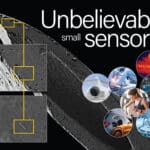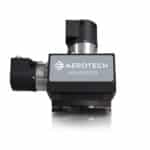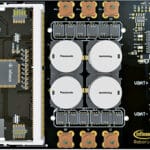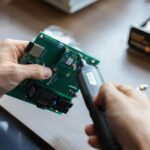 APPLY HERE ON LINKEDIN Location: Bengaluru Company: Tech Mahindra The team is looking for an ES who is responsible for the design and deployment of systems, which carry out calibration and performance validation of the Sensors Function on a well known tablet product line. The ES will be responsible for the full spectrum of the […]
APPLY HERE ON LINKEDIN Location: Bengaluru Company: Tech Mahindra The team is looking for an ES who is responsible for the design and deployment of systems, which carry out calibration and performance validation of the Sensors Function on a well known tablet product line. The ES will be responsible for the full spectrum of the […]View more at https://www.electronicsforu.com/career/hardware-test-engineer-tech-mahindra-bengaluru.
Credit- EFY. Distributed by Department of EEE, ADBU: https://tinyurl.com/eee-adbu
Curated by Jesif Ahmed
 Printed sensors as small as a micron are moving from lab-scale novelty to real-world deployment, opening new possibilities for robotics, surgery, batteries, and biosensing. Nanoscale temperature and force sensors small enough to be invisible to the naked eye are now ready for large-scale deployment, marking a significant step toward truly pervasive sensing across machines and […]
Printed sensors as small as a micron are moving from lab-scale novelty to real-world deployment, opening new possibilities for robotics, surgery, batteries, and biosensing. Nanoscale temperature and force sensors small enough to be invisible to the naked eye are now ready for large-scale deployment, marking a significant step toward truly pervasive sensing across machines and […] A new family of high-speed data converters brings advanced digital signal processing directly onto the ADC, cutting system complexity, cost, and FPGA load in demanding signal-chain designs. A newly launched family of high-speed analog-to-digital converters (ADCs) by Silanna Semiconductor is reshaping signal-chain design by integrating a feature-rich digital signal processor (DSP) directly onto the converter. […]
A new family of high-speed data converters brings advanced digital signal processing directly onto the ADC, cutting system complexity, cost, and FPGA load in demanding signal-chain designs. A newly launched family of high-speed analog-to-digital converters (ADCs) by Silanna Semiconductor is reshaping signal-chain design by integrating a feature-rich digital signal processor (DSP) directly onto the converter. […] A small sensor tracks movement, gestures, and speech while saving battery. See how it makes wearable devices smarter and longer lasting. When you work with wearables, hearables, or small robots, you quickly run into a few common challenges. Have you noticed how hard it can be to track fast or complex movements accurately without draining […]
A small sensor tracks movement, gestures, and speech while saving battery. See how it makes wearable devices smarter and longer lasting. When you work with wearables, hearables, or small robots, you quickly run into a few common challenges. Have you noticed how hard it can be to track fast or complex movements accurately without draining […] Dive in to know how this high-precision, multi-axis laser scanning can improve medical, electronics, semiconductor and advanced additive manufacturing processes As laser micromachining expands across industries, manufacturers demand systems that combine precision, speed and stability without excessive cost. Existing solutions often require trade-offs between resolution, dynamics and integration flexibility, limiting their deployment in research, medical, […]
Dive in to know how this high-precision, multi-axis laser scanning can improve medical, electronics, semiconductor and advanced additive manufacturing processes As laser micromachining expands across industries, manufacturers demand systems that combine precision, speed and stability without excessive cost. Existing solutions often require trade-offs between resolution, dynamics and integration flexibility, limiting their deployment in research, medical, […]
 Looking to build robots without starting from scratch? These ready-made reference designsillustrate how to make robots work faster and smarter. Robots are transforming how you work, live, and build systems. They take on tough, repetitive, or hazardous tasks, allowing you to focus on higher-value problem-solving. However, building a robot from the ground up is not […]
Looking to build robots without starting from scratch? These ready-made reference designsillustrate how to make robots work faster and smarter. Robots are transforming how you work, live, and build systems. They take on tough, repetitive, or hazardous tasks, allowing you to focus on higher-value problem-solving. However, building a robot from the ground up is not […] No wristbands, no patches, no gadgets—just Wi-Fi. Find out how your heartbeat can be tracked invisibly using signals already in your home. In recent years, growing public interest in health has made ubiquitous monitoring a key focus for researchers and users alike. Traditional methods for tracking vital signs rely on wearables that make contact with […]
No wristbands, no patches, no gadgets—just Wi-Fi. Find out how your heartbeat can be tracked invisibly using signals already in your home. In recent years, growing public interest in health has made ubiquitous monitoring a key focus for researchers and users alike. Traditional methods for tracking vital signs rely on wearables that make contact with […] A compact sensor captures fast voltage and current changes in real time, helping utilities monitor modern grids shaped by renewables, power electronics and data centres. As power grids absorb more renewable energy, data centres and battery systems, utilities are struggling to track fast electrical changes driven by modern power electronics. Traditional monitoring tools often miss […]
A compact sensor captures fast voltage and current changes in real time, helping utilities monitor modern grids shaped by renewables, power electronics and data centres. As power grids absorb more renewable energy, data centres and battery systems, utilities are struggling to track fast electrical changes driven by modern power electronics. Traditional monitoring tools often miss […] Satellites are now smart enough to think in space. How does this help us on Earth? What problems does it solve? In a talk with Nidhi Agarwal from EFY, Vishesh Vatsal from SkyServe, shares how AI works in orbit and why it matters… Q. What made you start this company and come up with this […]
Satellites are now smart enough to think in space. How does this help us on Earth? What problems does it solve? In a talk with Nidhi Agarwal from EFY, Vishesh Vatsal from SkyServe, shares how AI works in orbit and why it matters… Q. What made you start this company and come up with this […]